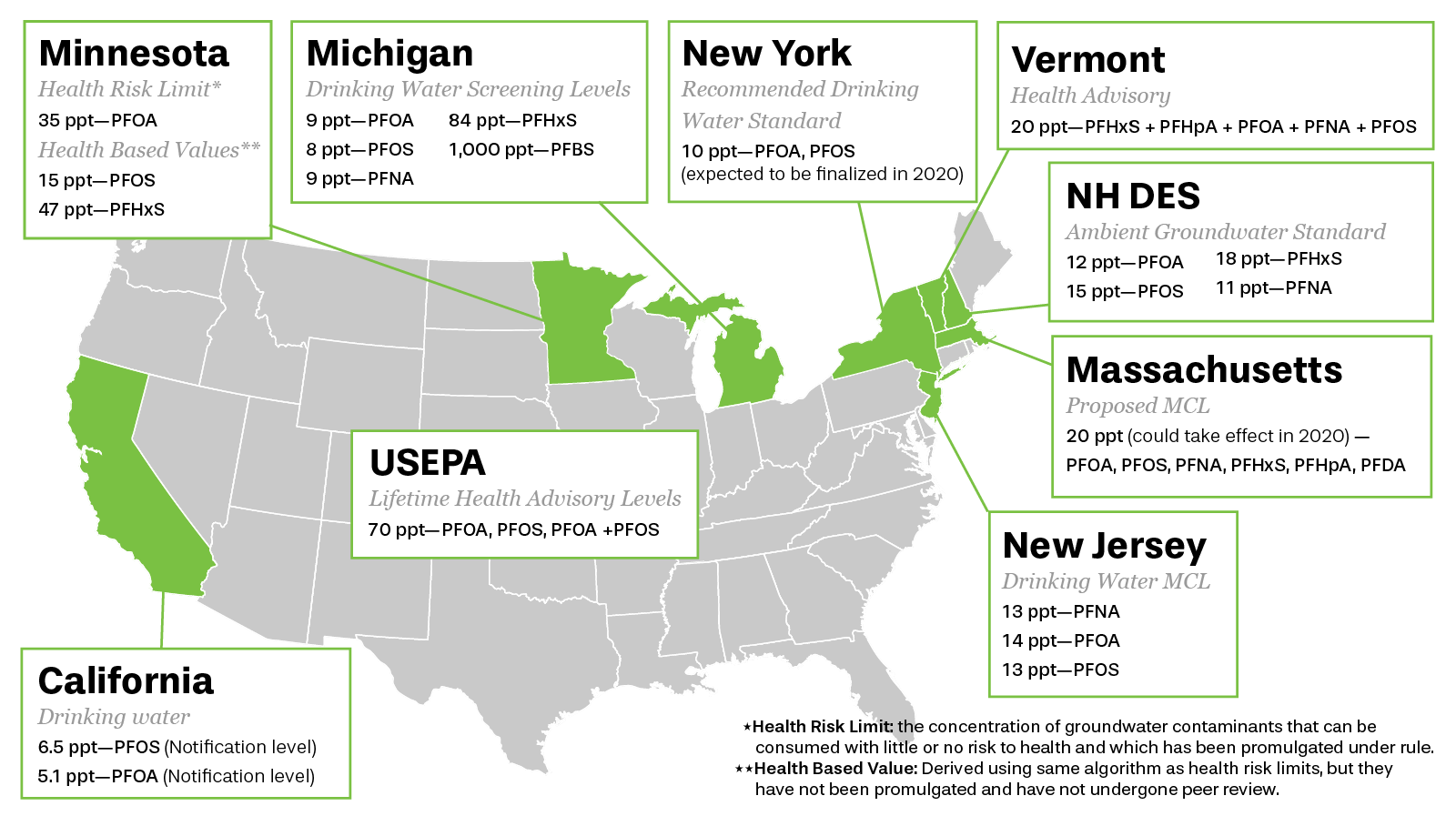PFAS 2020: U.S. Legislators Push PFAS in Election Year
In 2019, the topic of PFAS gained new political and cultural significance thanks to a combination of federal- and state-level action plans, increased media coverage and the premiere of a major motion picture, with the manmade chemical compounds starring alongside Hollywood heavyweights. This year, lawmakers around the country are counting on that momentum to make way for potentially seismic shifts in the way we label and treat PFAS. Federal agencies and legislators have yet to mandate binding policy like maximum contaminant levels (MCLs), but some politicians, including many presidential candidates, are signaling their desire to see increased regulation.
PFAS Action Act
On January 10, 2020, the U.S. House of Representatives passed H.R. 535, also known as the “PFAS Action Act.” Originally introduced by Rep. Debbie Dingell (D-MI) in early 2019 as a means of requiring the U.S. Environmental Protection Agency (EPA) to declare certain PFAS compounds hazardous substances, the bill has since been amended to include the establishment of:
- National drinking water standards, starting with MCLs for PFOA and PFOS
- Destruction and disposal guidance for a range of materials, like landfill leachate, biosolids and certain waste streams from manufacturing facilities
- Grant programs for communities with PFAS levels higher than the national standards
- Bans on PFAS in certain food packaging and reporting guidelines for manufacturers
Having passed the House, however, the bill is now headed to the Senate, where the Republican majority has already objected to many of its provisions. The Trump administration has also expressed its opposition to H.R. 535, stating that EPA should take the lead in regulating this contaminant.
PFAS is also a hot topic on the presidential campaign trail, where numerous candidates have cited PFAS contamination as an element of their platforms. PFAS is commonly cited by presidential contenders alongside lead contamination and aging infrastructure as among the largest environmental issues to be addressed in 2020. With PFAS staying at the top of agendas on Capitol Hill and on the stump, it seems likely that politicians will continue to focus on regulation and legislation through Election Day and beyond.

Meanwhile, at the State Level…
From coast to coast, a mosaic of regulatory actions is taking shape:
California: PFOA and PFOS are listed as potential “developmental toxicants” under Proposition 65, which requires manufacturers and distributors to alert consumers if certain products contain the compounds. State lawmakers have reportedly been working toward a still undetermined MCL; in the meantime, the State Water Resources Control Board has lowered notification levels to 5.1 ppt. (the federal health advisory is 70 ppt.)
Connecticut: Governor Ned Lamont released the state’s official PFAS Action Plan on November 4, 2019, which is expected to lead to MCL recommendations. The plan also includes an evaluation of PFAS levels in compost from food waste containers, disposable cutlery, and paper products.
Michigan: State officials believe nearly 2 million residents have been exposed to some amount of PFAS contamination via their drinking water, and State Attorney General Dana Nessel has recently filed a lawsuit against certain chemical companies. The lawsuit alleges those companies concealed the dangers of PFAS. The state also kicked off a series of public hearings as part of a process to determine potential statewide drinking standards. Currently, Michigan is still the only state that regulates PFAS in surface water.
Minnesota: The state has released health-based values and health risk limits below the federal health advisory, for PFOA (35 ppt) and PFOS (15 ppt), as well as enforceable discharge limits for certain water bodies.
Massachusetts: State officials have announced that they will be recommending a state MCL of 20 ppt, which could take effect in 2020.
New Hampshire: The state legislature has approved some of the most ambitious PFAS limits to date, including the first requirements for local water systems, landfills and wastewater plants to routinely test for four compounds: PFOA (12 ppt), PFOS (15 ppt), PFHxS (18 ppt) and PFNA (11 ppt). However, the regulations are on hold while 3M challenges the decision in court.
New Jersey: The state still has the only active MCLs for PFAS compounds: PFOA (14 ppt), PFOS (13 ppt), PFNA 13 ppt).
New York: The state health commissioner has accepted recommendations for the lowest standards for PFOA and PFOS (10 ppt) in the nation, but the Governor’s Office is providing a deferral period for municipal water utilities to prepare for the new regulations.
Vermont: The state has added three more compounds to its health advisory for drinking water. Added together, the levels of the following PFAS compounds may not exceed 20 ppt: PFOA, PFOS, PFHxS, PFHpA, PFNA.
Washington: A bill recently signed by Governor Jay Inslee banning consumer products from containing PFAS will not take effect until 2022.
For more details on statewide implementation of PFAS standards, consult the standards and guidance spreadsheet from the Interstate Technology Regulatory Council (ITRC).


The future of PFAS is about options: optimizing upstream treatment technology, reducing downstream waste generation, and destroying PFAS.
